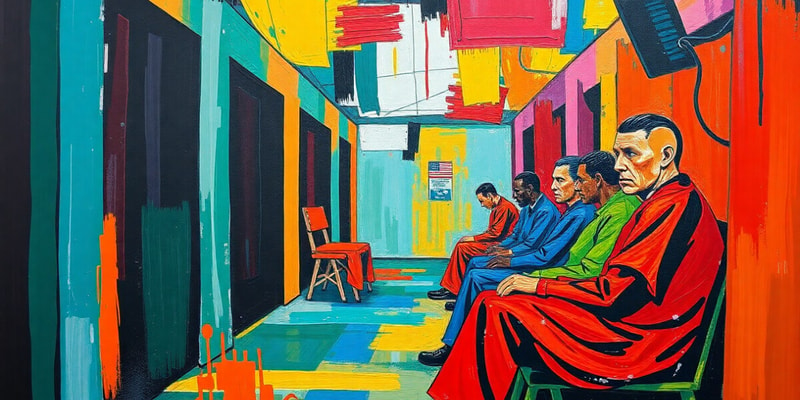Podcast Beta
Questions and Answers
What are special populations in correctional facilities?
Which of the following is NOT considered a special population in correctional settings?
What factors contribute to the formation of inmate societies?
Inmates often align themselves with others for which of the following reasons?
Signup and view all the answers
How should correctional staff respond to special populations?
Signup and view all the answers
What is a characteristic of racial societies formed by inmates?
Signup and view all the answers
How do religious societies among inmates influence their daily activities?
Signup and view all the answers
What is a common identifier for geographical societies among inmates?
Signup and view all the answers
Which of the following statements is true about the leadership dynamics in inmate societies?
Signup and view all the answers
What is typically true about inmates from lower socioeconomic groups?
Signup and view all the answers
Study Notes
Special Populations
- Special populations are groups of inmates that have unique characteristics that differ from the general population.
- These populations require non-traditional and innovative responses from staff.
- Special populations include:
- Gang members
- People with substance use disorder
- People with mental illness or an intellectual disability
- People with chronic medical conditions or physical disabilities
- Women
- The elderly
- Juveniles
- People who are LGBTQ+
- People in special confinement or on death row
Inmate Societies
- Inmates form societies based on:
- Race
- Religion
- Medical needs
- Geographical identity
- Ethnicity
- Cultural background
- Socioeconomic status
- These societies form because of common backgrounds, interests, and for protection.
- Inmates can align with others they perceive as having power and mimic their behavior.
- Inmate societies may have a hierarchical structure with a leader, sub-leaders, and followers.
- The hierarchy of an inmate society can change frequently due to events like fights, releases, intakes, and changes in resources.
- Elderly inmates typically do not have a leader.
- Youthful offender societies often lack the discipline to maintain a leadership structure.
Types of Inmate Societies
- Racial societies: May be a blend of multiple racial groups, not necessarily representing a single race.
- Religious societies: Guide daily activities, such as praying five times a day, carrying a rosary, or fasting.
- Medical societies: Share medical experiences and hardships.
- Geographical societies: Inmates from the same region may form groups and use identifiers like area codes and city names.
- Socioeconomic societies: May control activities within the inmate population with money, contraband, and influence.
Studying That Suits You
Use AI to generate personalized quizzes and flashcards to suit your learning preferences.
Related Documents
Description
This quiz explores the unique characteristics of special populations within the inmate community. It examines how these groups, including gang members, individuals with disabilities, and the elderly, require tailored responses from staff. Additionally, it delves into the formation of inmate societies based on race, religion, and more, highlighting the dynamics at play in correctional environments.



